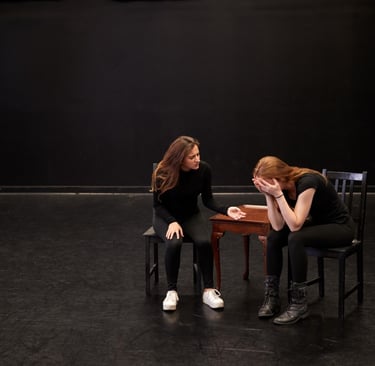Inner Monologue and Adaptation in the Stanislavski Acting Method
Discover how to use inner monologue and adaptation in acting by utilizing the Stanislavski acting method to create truthful, grounded performances—even in moments of silence.
THEATRE STUDENT RESOURCES
Katie Zakkak
10/24/20253 min read


🎭 Actors and drama teachers—before we begin, don’t miss these free resources:
✅For Actors - Free Audition Materials Guide: The 8 pieces you need for nearly every theater audition
✅ For Drama Teachers - Drama Classroom Toolkit: Perfect for teachers and afterschool programs
✅If you’re looking for personalized support, check out my Classes and Coaching page to learn more about how I can help you grow as an actor.
Emotional Memory:
You've probably heard the phrase, “acting is reacting,” but what does that really mean? How do we stay alive, emotionally responsive, and fully present—even when it's not our line?
In this post from the Stanislavski Acting Method series, we’ll explore two key tools that help actors bring scenes to life: adaptation and inner monologue.
These tools allow you to go beyond line delivery and create a grounded, realistic character—even during moments of silence.
What Is Adaptation?
Adaptation refers to how your character adjusts and reacts to what’s happening in the moment. It’s the actor’s ability to stay present and responsive onstage—not just delivering rehearsed lines, but actually listening and reacting as if everything is unfolding in real time.
Even though you know what’s coming next in the script, your character doesn’t. That’s where adaptation comes in. If your scene partner plays their line with a new tone or tactic, how does your character react? What shifts internally? How does it change your response?
Adaptation is what keeps the scene alive.
What Is Inner Monologue?
Inner monologue is what your character is thinking throughout the scene—even when they're silent.
Just like in real life, our minds are constantly processing what's happening, forming opinions, and preparing responses. The same should be true for your character.
Even in moments of stillness, there should be thoughts happening. And when you connect to those thoughts, the audience can often feel the inner life of the character—even without words.
Example: Romeo and Juliet
Let’s look at an example from Shakespeare’s Romeo and Juliet. In the famous balcony scene, Juliet delivers a long soliloquy:
“O Romeo, Romeo! Wherefore art thou Romeo?”
But while Juliet speaks, Romeo is silently listening.
If you’re playing Romeo, your job is not to just stand there waiting for your next line. You need to think through each of Juliet’s lines and respond emotionally. What does he feel when he hears his name? Relief? Excitement? Hope?
As Juliet wrestles with the idea of their feuding families, Romeo might think, "She’s going to reject me." Then, when she talks herself out of that worry, Romeo's thoughts shift again: "She wants to be with me!"
Those inner thoughts shape everything Romeo does in that moment—even though he says nothing.
Exercise: Practicing Inner Monologue and Adaptation
Here’s a simple but powerful exercise to apply these tools to your acting. For this exercise, you will need a scene where another person is talking for a significant portion of the script and a notebook.
1. Choose a Scene
Pick a scene where your character has a long stretch of silence (ideally, while someone else is delivering a monologue or emotional speech).
2. Write an Inner Monologue
As you read through the scene, write down what your character is thinking during those silent moments. Focus on reactions to the other character’s lines, internal fears, hopes, doubts, or decisions being formed in real time.
3. Perform the Scene with a Partner
If you’re at home, have a friend or family member read the other character’s lines aloud. If you’re in a classroom or rehearsal setting, work in pairs and trade scenes.
4. Reflect
After performing, ask yourself:
How did your inner monologue change your reactions?
Did your tone, gestures, or energy shift based on what you imagined your character was thinking?
Practicing this will also help you feel more prepared for cold readings and auditions. Directors are always watching how actors listen and react, not just how they speak.
Why This Matters
Adaptation and inner monologue bring depth to your work. They help you play not just the words on the page, but the life happening beneath the surface.
When your character is always thinking, reacting, and adjusting, you’ll deliver performances that feel honest—even in silence.
Keep Growing
🎭 If this resonated with you, I invite you to check out:
My Classes and Coaching page for one-on-one support or small group learning
The Drama Classroom Toolkit, great for educators and student performers alike
Happy acting—and break a leg!


